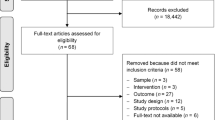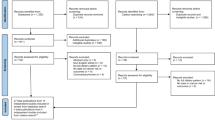Abstract
Objectives:
To evaluate the feasibility and long-term compliance with a low-fat diet supplemented with soy protein in men at increased risk for recurrence after radical prostatectomy.
Design:
Randomized, control study.
Setting:
Academic center in USA.
Subject:
Forty men who had undergone radical prostatectomy and were at increased risk for recurrence.
Intervention:
Low-fat (15% fat), high-fiber (18 g/1000 kcal) diet supplemented with 40 g soy protein isolate (n=26) was compared to USDA recommended diet (n=14).
Results:
Over 4 years, subjects in the intervention group but not in the control group made and sustained significant changes in their diet as measured by the dietary assessment instruments and urinary isoflavone excretion. In the intervention group, dietary fat intake was reduced from 33.46±1.27% energy/day to 21.04±1.74% (P<0.05), fiber intake increased from 14.6±1.06 to 21.05±2.29 g/day. The insulin growth factor-1 (IGF-1) level was decreased from 260.4±8.6 ng/ml at baseline to 220.5±7.9 ng/ml at 6 months (P<0.05) in the intervention group with no significant change in the control group. An ex vivo assay demonstrated inhibition of LNCaP cell growth (−20.0±7.7%, P<0.05) by sera from patients in the intervention group after 6 months of dietary change compared to baseline.
Conclusion:
These data suggest that long-term low-fat dietary interventions as part of prospective randomized trials in prostate cancer survivors are feasible, and lead to reductions in circulating hormones or other growth factors stimulating prostate cancer growth ex vivo.
This is a preview of subscription content, access via your institution
Access options
Subscribe to this journal
Receive 12 print issues and online access
$259.00 per year
only $21.58 per issue
Buy this article
- Purchase on Springer Link
- Instant access to full article PDF
Prices may be subject to local taxes which are calculated during checkout


Similar content being viewed by others
References
Adlercreutz H, Honjo H, Higashi A, Fotsis T, Hamalainen E, Hasegawa T et al. (1991). Urinary excretion of lignans and isoflavonoid phytoestrogens in Japanese men and women consuming a traditional Japanese diet. Am J Clin Nutr 54, 1093–1100.
Boyle P, Levi F, Lucchini F, La VC, Kevi R, Lucchuni F (1993). Trends in diet-related cancers in Japan: a conundrum? Lancet 342, 752.
Chan JM, Stampfer MJ, Giovannucci E, Gann PH, Ma J, Wilkinson P et al. (1998). Plasma insulin-like growth factor-I and prostate cancer risk: a prospective study. Science 279, 563–566.
Cohen P, Peehl DM, Baker B, Liu F, Hintz RL, Rosenfeld RG (1994). Insulin-like growth factor axis abnormalities in prostatic stromal cells from patients with benign prostatic hyperplasia. J Clin Endocrinol Metab 79, 1410–1415.
Collett-Solberg PF, Cohen P (1996). The role of the insulin-like growth factor binding proteins and the IGFBP proteases in modulating IGF action. Endocrinol Metab Clin North Am 25, 591–614.
Elmer PJ, Grimm Jr R, Laing B, Grandits G, Svendsen K, Van HN et al. (1995). Lifestyle intervention: results of the Treatment of Mild Hypertension Study (TOMHS). Prev Med 24, 378–388.
Ferry Jr RJ, Katz LE, Grimberg A, Cohen P, Weinzimer SA (1999). Cellular actions of insulin-like growth factor binding proteins. Horm Metab Res 31, 192–202.
Hebert JR, Hurley TG, Olendzki BC, Teas J, Ma Y, Hampl JS (1998). Nutritional and socioeconomic factors in relation to prostate cancer mortality: a cross-national study. J Natl Cancer Inst 90, 1637–1647.
Huang MH, Harrison GG, Mohamed MM, Gornbein JA, Henning SM, Go VL et al. (2000). Assessing the accuracy of a food frequency questionnaire for estimating usual intake of phytoestrogens. Nutr Cancer 37, 145–154.
Jeffery RW, Bjornson-Benson WM, Rosenthal BS, Lindquist RA, Kurth CL, Johnson SL (1984). Correlates of weight loss and its maintenance over two years of follow-up among middle-aged men. Prev Med 13, 155–168.
Jemal A, Murray T, Ward E, Samuels A, Tiwari RC, Ghafoor A et al. (2005). Cancer statistics, 2005. CA Cancer J Clin 55, 10–30.
Kaplan PJ, Mohan S, Cohen P, Foster BA, Greenberg NM (1999). The insulin-like growth factor axis and prostate cancer: lessons from the transgenic adenocarcinoma of mouse prostate (TRAMP) model. Cancer Res 59, 2203–2209.
Khuntia D, Reddy CA, Mahadevan A, Klein EA, Kupelian PA (2004). Recurrence-free survival rates after external-beam radiotherapy for patients with clinical T1-T3 prostate carcinoma in the prostate-specific antigen era: what should we expect? Cancer 100, 1283–1292.
Kondo Y, Homma Y, Aso Y, Kakizoe T (1994). Promotional effect of two-generation exposure to a high-fat diet on prostate carcinogenesis in ACI/Seg rats. Cancer Res 54, 6129–6132.
Lanza E, Schatzkin A, Daston C, Corle D, Freedman L, Ballard-Barbash R et al. (2001). Implementation of a 4-y, high-fiber, high-fruit-and-vegetable, low-fat dietary intervention: results of dietary changes in the Polyp Prevention Trial. Am J Clin Nutr 74, 387–401.
Mills PK, Beeson WL, Phillips RL, Fraser GE (1989). Cohort study of diet, lifestyle, and prostate cancer in Adventist men. Cancer 64, 598–604.
Ngo TH, Barnard RJ, Anton T, Tran C, Elashoff D, Heber D et al. (2004). Effect of isocaloric low-fat diet on prostate cancer xenograft progression to androgen independence. Cancer Res 64, 1252–1254.
Ngo TH, Barnard RJ, Tymchuk CN, Cohen P, Aronson WJ (2002). Effect of diet and exercise on serum insulin, IGF-I, and IGFBP-1 levels and growth of LNCaP cells in vitro (United States). Cancer Causes Control 13, 929–935.
Ornish D, Weidner G, Fair WR, Marlin R, Pettengill EB, Raisin CJ et al. (2005). Intensive lifestyle changes may affect the progression of prostate cancer. J Urol 174, 1065–1069.
Peterson G, Barnes S (1993). Genistein and biochanin A inhibit the growth of human prostate cancer cells but not epidermal growth factor receptor tyrosine autophosphorylation. Prostate 22, 335–345.
Rose DP, Connolly JM (1992). Dietary fat, fatty acids and prostate cancer. Lipids 27, 798–803.
Severson RK, Nomura AM, Grove JS, Stemmermann GN (1989). A prospective analysis of physical activity and cancer. Am J Epidemiol 130, 522–529.
Shike M, Latkany L, Riedel E, Fleisher M, Schatzkin A, Lanza E et al. (2002). Lack of effect of a low-fat, high-fruit, -vegetable, and -fiber diet on serum prostate-specific antigen of men without prostate cancer: results from a randomized trial. J Clin Oncol 20, 3592–3598.
Shimizu H, Ross RK, Bernstein L, Yatani R, Henderson BE, Mack TM (1991). Cancers of the prostate and breast among Japanese and white immigrants in Los Angeles County. Br J Cancer 63, 963–966.
Stattin P, Bylund A, Rinaldi S, Biessy C, Dechaud H, Stenman UH et al. (2000). Plasma insulin-like growth factor-I, insulin-like growth factor-binding proteins, and prostate cancer risk: a prospective study. J Natl Cancer Inst 92, 1910–1917.
Trapasso JG, deKernion JB, Smith RB, Dorey F (1994). The incidence and significance of detectable levels of serum prostate specific antigen after radical prostatectomy. J Urol 152, 1821–1825.
Tymchuk CN, Barnard RJ, Heber D, Aronson WJ (2001). Evidence of an inhibitory effect of diet and exercise on prostate cancer cell growth. J Urol 166, 1185–1189.
US Cancer Statistics Working Group (2003). United States Cancer Statistics: 2000 Incidence. Department of Health, Human Services, Centers for Disease Control, Prevention, National Cancer Institute, Atlanta.
Wang Y, Corr JG, Thaler HT, Tao Y, Fair WR, Heston WD (1995). Decreased growth of established human prostate LNCaP tumors in nude mice fed a low-fat diet. J Natl Cancer Inst 87, 1456–1462.
Whittemore AS, Kolonel LN, Wu AH, John EM, Gallagher RP, Howe GR et al. (1995). Prostate cancer in relation to diet, physical activity, and body size in blacks, whites, and Asians in the United States and Canada. J Natl Cancer Inst 87, 652–661.
Wynder EL, Rose DP, Cohen LA (1994). Nutrition and prostate cancer: a proposal for dietary intervention. Nutr Cancer 22, 1–10.
Yan L, Spitznagel EL (2005). Meta-analysis of soy food and risk of prostate cancer in men. Int J Cancer 20, 667–669.
Acknowledgements
CaPCure (currently Prostate Cancer Foundation), NIH Grants P30 CA 42710, T32 DK 57688, CA100938 and P50 CA92131.
Author information
Authors and Affiliations
Corresponding author
Additional information
Guarantor: D Heber.
Contributors: DH and WJA were involved in the protocol, study design, critical review of the article. ZL and KH participated in conduct the study, data analysis and writing of the article. JRA did the cell culture assay. WL and RE did the statistical analysis and critically reviewed the article. SMH performed biomarker assays and critical review of the article. GT and JMA participated in the study and reviewed the manuscript.
Rights and permissions
About this article
Cite this article
Li, Z., Aronson, W., Arteaga, J. et al. Feasibility of a low-fat/high-fiber diet intervention with soy supplementation in prostate cancer patients after prostatectomy. Eur J Clin Nutr 62, 526–536 (2008). https://doi.org/10.1038/sj.ejcn.1602743
Received:
Revised:
Accepted:
Published:
Issue Date:
DOI: https://doi.org/10.1038/sj.ejcn.1602743
Keywords
This article is cited by
-
Biochemical recurrence in patients with prostate cancer after primary definitive therapy: treatment based on risk stratification
Prostate Cancer and Prostatic Diseases (2024)
-
Phase II prospective randomized trial of weight loss prior to radical prostatectomy
Prostate Cancer and Prostatic Diseases (2018)
-
Does soy protein affect circulating levels of unbound IGF-1?
European Journal of Nutrition (2018)
-
A systematic review of dietary, nutritional, and physical activity interventions for the prevention of prostate cancer progression and mortality
Cancer Causes & Control (2015)
-
Fish oil slows prostate cancer xenograft growth relative to other dietary fats and is associated with decreased mitochondrial and insulin pathway gene expression
Prostate Cancer and Prostatic Diseases (2013)



